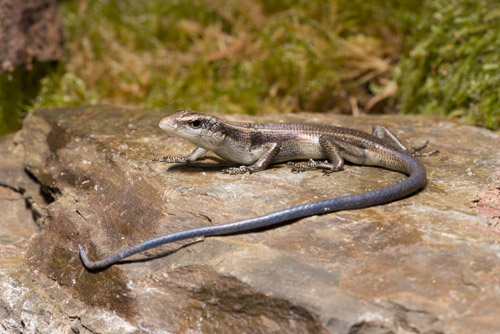Interactions
Emoia cyanura most commonly interacts
with other skinks in the genus Emoia, and is often grouped
together with the sibling species Emoia impar which shares many
characteristics and mainly differs in tail color. These
two skinks appear to coexist on all islands they are found on in
the Pacific, and actually show signs of habitat partitioning
(Schwaner and Ineich 1998) which would indicate a very
mutualistic relationship between the two. The
copper-tailed skink finds competition in the species
Cryptoblepharis boutoni; however this appears to only be in the
littoral region, the area around the shore (Schwaner and Ineich
1998). E. cyanura like many species is prey to
larger
animals, for example, in the Fiji islands the re
are areas where this terrestrial skink has almost been
eliminated due to mongoose predation (Zug 1991). It
appears to find itself the prey of fellow members of its
genus quite often as well. Researchers have observed E.
nigra chasing after E. cyanura, and have found that in areas
that have a larger population of E. nigra there is a noticeably
smaller population of E. cyanura (Zug 1991). This
particular skink can also have potential predators in E.
adspera, E. samoense, and E. lawesii (Schwaner and Ineich 1998).
In terms of interaction between individuals of the species there
appears to be a dominant hierarchy that is portrayed best
during sun basking which is popular throughout the class
Reptilia, take for example the
green sea turtle. The smaller E. cyanura skinks are the
first to come out of foliage and find a sun-soaked area to bask,
but eventually larger skinks of the species come out and take
over these areas (Zug 1991).
re
are areas where this terrestrial skink has almost been
eliminated due to mongoose predation (Zug 1991). It
appears to find itself the prey of fellow members of its
genus quite often as well. Researchers have observed E.
nigra chasing after E. cyanura, and have found that in areas
that have a larger population of E. nigra there is a noticeably
smaller population of E. cyanura (Zug 1991). This
particular skink can also have potential predators in E.
adspera, E. samoense, and E. lawesii (Schwaner and Ineich 1998).
In terms of interaction between individuals of the species there
appears to be a dominant hierarchy that is portrayed best
during sun basking which is popular throughout the class
Reptilia, take for example the
green sea turtle. The smaller E. cyanura skinks are the
first to come out of foliage and find a sun-soaked area to bask,
but eventually larger skinks of the species come out and take
over these areas (Zug 1991).
Return to Homepage.
Next page
Facts.